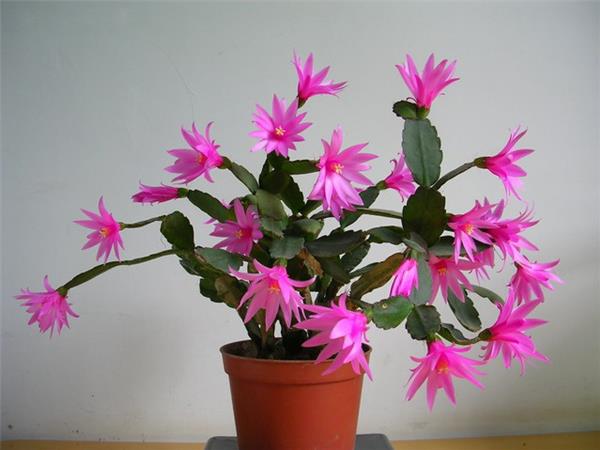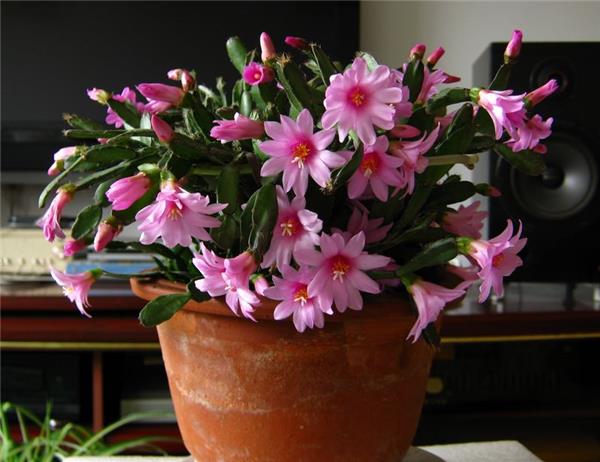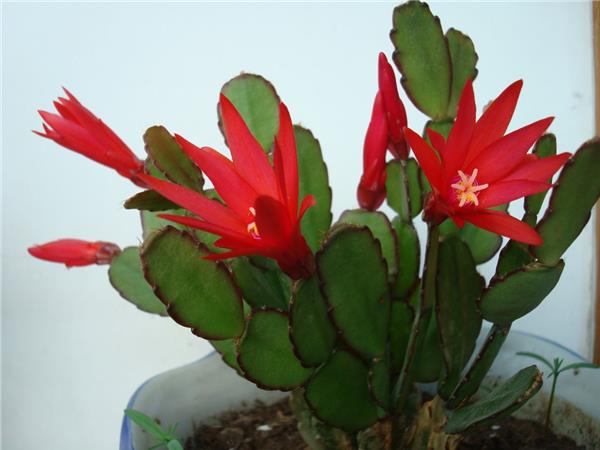What is false epiphyllum? matters needing attention in the cultivation of false epiphyllum
The shape of false epiphyllum is more like crab claw orchid and fairy finger, there are small short bristles on the edge of the leaf, especially like the feet of crabs, so it is also called "crab flower". Next, let's take a look at how to raise fake epiphyllum.

1. Morphological characteristics of false epiphyllum.
False epiphyllum is an epiphytic succulent plant of Cactaceae and epiphyllum, which is native to tropical South America, especially in Brazil, and is cultivated all over the world. It looks like crab claw orchid and fairy finger. Flowers with stem nodes at the top, red, flowers large and neat petals, showing a standard radiation, plant height of 15 to 20 meters, much branched, leaves have been degraded, branches are stem node-like overhang. The stem is oval, flat, nodal, turquoise, nodal side wavy or engraved, with short hairs or a little yellow bristles in the axils of the round teeth, which is very similar to the shape of the fairy finger, so it is also called "crab flower". The kaleidoscope is short, with a diameter of 6 to 8 meters; the petals extend widely and are standard radiant flowers with orange-red and bright colors, usually blooming from March to April, coinciding with Easter in Europe and the United States, so it is also known as the "Easter cactus". The fruit is 5-angled, about 1.5 cm long, and the florescence is from March to April.

2. Propagation methods of false epiphyllum
Cuttings: from March to April, cut the sturdy stem nodes and insert them into the sand bed to keep them moist. Under the temperature of 25 ℃, they can take root in about 40 days. When the young roots change from white to yellowish brown, they can be cultivated in pots. Put some organic fertilizer on the bottom of the basin and put it on top of seven before releasing seedlings for cultivation.
Grafting: in order to cultivate umbrella-shaped overhanging plants to increase ornamental value, grafting can be used for reproduction. Grafting is usually carried out in spring and autumn. The rootstock is widely used, such as leaf cactus and flaky cactus. If you use day ruler as rootstock, connect a scion at each of the three edges; if you choose leaf cactus or flaky cactus as rootstock, cut a crack longitudinally at the top, peel the two sides of the scion with a blade to expose the xylem, insert it directly into the cut of the rootstock, bind it with plastic strips and cover it with a plastic bag, and place it in a shaded place for maintenance.
Sowing method: it is mainly used for the cultivation of new varieties. It takes four or five years for Hong to blossom from sowing. False epiphyllum could germinate after sowing about 2 Mel for 3 weeks.

III. Matters needing attention in the culture of false epiphyllum
Habits: false flowers like a warm, humid and sunny environment. Not cold-resistant, avoid bright light. The soil requires acidic sandy loam rich in humus. The winter temperature is not lower than 5 ℃.
Potted soil: use 3 parts of peat soil or rotten leaf soil plus 1 part of sand or perlite as pot soil.
Watering: false epiphyllum needs sufficient water throughout the growth and flowering period to keep the basin soil moist, but avoid stagnant water in the basin. There is a dormancy period of 2-3 weeks after the end of flowering. It is necessary to water less and only keep the basin soil not completely dry. Gradually increase the amount of water after the dormant period. At the beginning, the surface of the basin soil dries about 1 centimeter, and when the bottom soil is still wet, it can be watered until the beginning of spring.
Fertilization: the mixed liquid fertilizer of nitrogen and phosphorus was applied every 20 days in the growing season, and more phosphorus and potassium fertilizer was applied in the bud stage.
Lighting: fake county flowers like semi-overcast environment, should be placed in a semi-shady, well-ventilated and cool place, to avoid too much Rain Water. There can be no light in the greenhouse in winter. Indoors, winter can be placed in the sunny window or closed balcony, overwintering temperature of not less than 10 ℃.
Pruning: the new buds on the abnormal stems should be removed in time at the bud stage, so that nutrients can be concentrated on the buds; after flowering, the old branches should be pruned in time, and nitrogen fertilizer should be applied properly once or twice.

Generally speaking, it is a popular way to propagate false epiphyllum by grafting. If it is grafted on solid succulent plants such as cactus and keel, it can be mutually beneficial and win-win, which can improve the ornamental value and depend on each other.
Related
- Wuhan Hospital Iron Tree Blooming Result Was Instantly Frightened by the Gardener Master
- Which variety of camellia is the most fragrant and best? Which one do you like best?
- What is the small blue coat, the breeding methods and matters needing attention of the succulent plant
- Dormancy time and maintenance management of succulent plants during dormancy
- Minas succulent how to raise, Minas succulent plant pictures
- What are the varieties of winter succulent plants
- How to raise succulent plants in twelve rolls? let's take a look at some experience of breeding twelve rolls.
- Attention should be paid to water control for succulent plants during dormant period (winter and summer)
- Watering experience of twelve rolls of succulent plants
- Techniques for fertilizing succulent plants. An article will let you know how to fertilize succulent plants.



